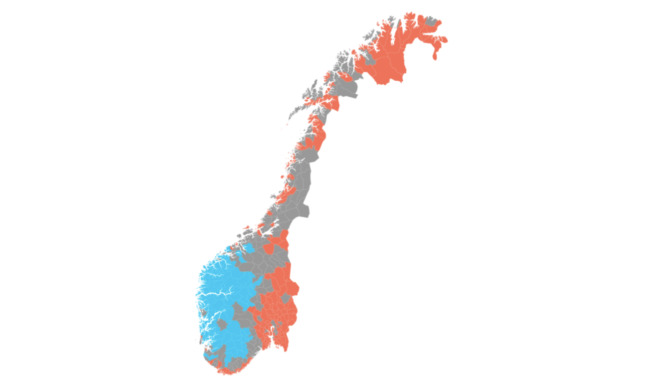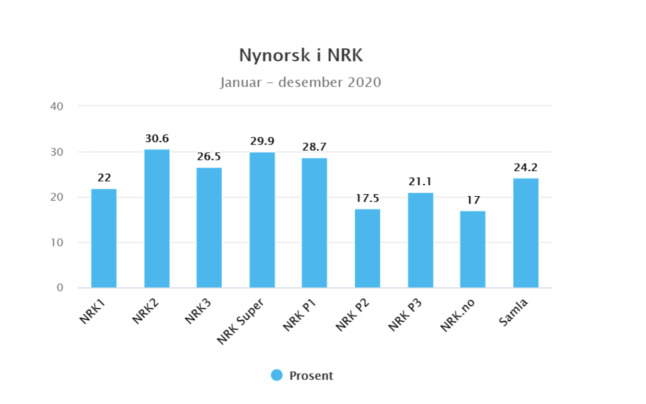Nynorsk: Why Norway's second written language is more important than you think

Nynorsk - Norway's second official written language - is a key part of the country's history and is the official form of Norwegian in parts of the country.
One of the many things that helps to make the small country of Norway unquie is its language. The Norwegian language is quite unique in being a polynomic language — a language with more than one written form.
These two written forms are Bokmål and Nynorsk. And while Bokmål may be the more popular of the two, Nynorsk, which translates as "new/modern Norwegian", is still used by 10-15 percent of the population and is mandatory in schools.
How there came to be two variations of Norwegian in Norway
Norwegian is considered to be a part of the North Germanic languages, which include: Swedish, Danish, Icelandic, and Faroese. All of these languages stem from the same parent language, Old Norse. Old Norse was eventually replaced by Danish (though not in Iceland).
In the 1530s, Norway was under Danish rule when Protestantism replaced Catholicism. As a result, Danish became even more prominent in Norway as all holy texts were in Danish.
Nynorsk came to the fore in the 1800s when Norway was under Swedish rule but still allowed to operate semi-independently.
Around this time, many Norwegians found it problematic that Danish was so prevalent in Norway and began a linguistic reformation, pivoting from Danish to Norwegian.
A linguist called Ivar Aasen created a written standard based on regional dialects in rural areas, as he felt those would be closer to Norwegian. In 1853, he published a written standard based on these dialects and called it landsmål. This would later become what is known as what is known as Nynorsk today.
This happened around the same time riksmål was formed, another attempt to pivot the language from Danish towards Norwegian. Riksmål would become Bokmål, the dominant form of written Norwegian. Both would receive status as official languages.
How similar is Nynorsk to Bokmål?
Depending on where you settle in Norway, you may be offered Norwegian courses either in Bokmål or Nynorsk. Even though the languages are similar, do not switch between the two while learning the language, as it could make learning the grammar complicated and impact how you pronounce certain words.
Orally, there isn't an official difference because the two are, officially, purely written languages. Instead, differences in spoken Norwegian mainly stem from different regional dialects. The way some dialects are pronounced can sound similar to how one would expect Nynorsk to be pronounced were it a spoken language.
The written form is where the most significant difference is seen. Nynorsk is mainly used in Western and Central Norway by about 10 percent of residents.
A town or municipality in this country can decide if Nynorsk or Bokmål will be the official language. They can also decide to not choose between the two and be standard neutral. A quick way to identify if you are driving through or staying in a municipality that uses mainly Nynorsk is by looking at the road signs and noticing how directions are spelt on them.
Below is a map representing municipalities that have declared Nynorsk as the official language (in blue), Bokmål (in red), and standard neutral (in grey).

Source: Norwegian Language Learning
Can I understand Nynorsk if I am not from Norway and have learned Bokmål?
Generally, yes. But the amount you're able to understand depends on your level of Norwegian. You've likely already noticed Norway has plenty of different dialects, with some being more difficult to understand than others.
You will likely understand what a local is saying to you in a dialect Nynorsk is derived from, but reading it would prove to be a bit more complicated.
Below is an example provided by Norwegian Language Learning.
Bokmål: Vi har syv / sju ravner, en / ei kråke og flere linerler.
Nynorsk: Vi / Me har sju ramnar, ei kråke og fleire linerler.
English: We have seven ravens, a crow, and several wagtails.
As one can see, the spelling and the lack of masculine and feminine article options in Nynorsk are obvious separators of the two languages.
Another noticeable grammatical difference between Nynorsk and Bokmål is that plural endings for masculine gender nouns are different. Take en hund, or "a dog", for example.
Bokmål: hunder
Nynorsk: hundar
English: dogs
The government's regulation of Nynorsk in the media
Even though a large part of the population in Norway uses Bokmål, the Norwegian government has rules set in place to make sure Nynorsk is represented. The use of Nynorsk is regulated in public service institutions such as in the media.
State-owned broadcasting company NRK must have at least 25 percent of its verbal elements in both television and radio be in regional dialects. This could be confusing for foreigners if they were not aware. A newcomer can click on an article to read on the NRK website and suddenly not be able to decipher the text. Don't worry about your language skills slipping, as the article is likely written in Nynorsk.
Below is a graph showing how much Nynorsk was used in each of the NRK channels last year.

There is a third official language in parts of Norway
Bokmål and Nynorsk may be the two official administrative languages in Norway. But in some parts of the country, Samisk or "Sami" has an official standing. Sami is the language spoken by the native Sami people of Norway.
Two variations of Sami are spoken, though two-thirds of the residents who speak it (mainly in Troms and Finnmark in the North) speak North Sami over its counterpart, East Sami. You can find articles or newspapers written in Sami, though the use of it in government and education in Norway is almost non-existent.
Sami has the status of a minority language in Norway, Sweden and Finland. However, Sami has the status of an official language in Sami administrative areas within the countries. Unlike the similarities between Nynorsk and Bokmål, Sami derives from the Fenno-Ugrian languages and can not be understood by even native Norwegian speakers.
Vocabulary in Nynorsk and useful facts
Ivar Aasen is considered the creator of Nynorsk. As a language researcher, he both collected and systemised different dialects around Norway. His work is the basis for what we know today as Nynorsk.
Previously, learning Nynorsk in school was a requirement. At the time of writing, The Education Act is being reviewed, and any changes for Nynorsk will be announced when new legislation has been enacted. The debate over the continued study of Nynorsk in schools has been quite active in the media for years.
skule - school
korkje - neither
naudsynt - necessary
Comments
See Also
One of the many things that helps to make the small country of Norway unquie is its language. The Norwegian language is quite unique in being a polynomic language — a language with more than one written form.
These two written forms are Bokmål and Nynorsk. And while Bokmål may be the more popular of the two, Nynorsk, which translates as "new/modern Norwegian", is still used by 10-15 percent of the population and is mandatory in schools.
How there came to be two variations of Norwegian in Norway
Norwegian is considered to be a part of the North Germanic languages, which include: Swedish, Danish, Icelandic, and Faroese. All of these languages stem from the same parent language, Old Norse. Old Norse was eventually replaced by Danish (though not in Iceland).
In the 1530s, Norway was under Danish rule when Protestantism replaced Catholicism. As a result, Danish became even more prominent in Norway as all holy texts were in Danish.
Nynorsk came to the fore in the 1800s when Norway was under Swedish rule but still allowed to operate semi-independently.
Around this time, many Norwegians found it problematic that Danish was so prevalent in Norway and began a linguistic reformation, pivoting from Danish to Norwegian.
A linguist called Ivar Aasen created a written standard based on regional dialects in rural areas, as he felt those would be closer to Norwegian. In 1853, he published a written standard based on these dialects and called it landsmål. This would later become what is known as what is known as Nynorsk today.
This happened around the same time riksmål was formed, another attempt to pivot the language from Danish towards Norwegian. Riksmål would become Bokmål, the dominant form of written Norwegian. Both would receive status as official languages.
How similar is Nynorsk to Bokmål?
Depending on where you settle in Norway, you may be offered Norwegian courses either in Bokmål or Nynorsk. Even though the languages are similar, do not switch between the two while learning the language, as it could make learning the grammar complicated and impact how you pronounce certain words.
Orally, there isn't an official difference because the two are, officially, purely written languages. Instead, differences in spoken Norwegian mainly stem from different regional dialects. The way some dialects are pronounced can sound similar to how one would expect Nynorsk to be pronounced were it a spoken language.
The written form is where the most significant difference is seen. Nynorsk is mainly used in Western and Central Norway by about 10 percent of residents.
A town or municipality in this country can decide if Nynorsk or Bokmål will be the official language. They can also decide to not choose between the two and be standard neutral. A quick way to identify if you are driving through or staying in a municipality that uses mainly Nynorsk is by looking at the road signs and noticing how directions are spelt on them.
Below is a map representing municipalities that have declared Nynorsk as the official language (in blue), Bokmål (in red), and standard neutral (in grey).

Source: Norwegian Language Learning
Can I understand Nynorsk if I am not from Norway and have learned Bokmål?
Generally, yes. But the amount you're able to understand depends on your level of Norwegian. You've likely already noticed Norway has plenty of different dialects, with some being more difficult to understand than others.
You will likely understand what a local is saying to you in a dialect Nynorsk is derived from, but reading it would prove to be a bit more complicated.
Below is an example provided by Norwegian Language Learning.
Bokmål: Vi har syv / sju ravner, en / ei kråke og flere linerler.
Nynorsk: Vi / Me har sju ramnar, ei kråke og fleire linerler.
English: We have seven ravens, a crow, and several wagtails.
As one can see, the spelling and the lack of masculine and feminine article options in Nynorsk are obvious separators of the two languages.
Another noticeable grammatical difference between Nynorsk and Bokmål is that plural endings for masculine gender nouns are different. Take en hund, or "a dog", for example.
Bokmål: hunder
Nynorsk: hundar
English: dogs
The government's regulation of Nynorsk in the media
Even though a large part of the population in Norway uses Bokmål, the Norwegian government has rules set in place to make sure Nynorsk is represented. The use of Nynorsk is regulated in public service institutions such as in the media.
State-owned broadcasting company NRK must have at least 25 percent of its verbal elements in both television and radio be in regional dialects. This could be confusing for foreigners if they were not aware. A newcomer can click on an article to read on the NRK website and suddenly not be able to decipher the text. Don't worry about your language skills slipping, as the article is likely written in Nynorsk.
Below is a graph showing how much Nynorsk was used in each of the NRK channels last year.

There is a third official language in parts of Norway
Bokmål and Nynorsk may be the two official administrative languages in Norway. But in some parts of the country, Samisk or "Sami" has an official standing. Sami is the language spoken by the native Sami people of Norway.
Two variations of Sami are spoken, though two-thirds of the residents who speak it (mainly in Troms and Finnmark in the North) speak North Sami over its counterpart, East Sami. You can find articles or newspapers written in Sami, though the use of it in government and education in Norway is almost non-existent.
Sami has the status of a minority language in Norway, Sweden and Finland. However, Sami has the status of an official language in Sami administrative areas within the countries. Unlike the similarities between Nynorsk and Bokmål, Sami derives from the Fenno-Ugrian languages and can not be understood by even native Norwegian speakers.
Vocabulary in Nynorsk and useful facts
Ivar Aasen is considered the creator of Nynorsk. As a language researcher, he both collected and systemised different dialects around Norway. His work is the basis for what we know today as Nynorsk.
Previously, learning Nynorsk in school was a requirement. At the time of writing, The Education Act is being reviewed, and any changes for Nynorsk will be announced when new legislation has been enacted. The debate over the continued study of Nynorsk in schools has been quite active in the media for years.
skule - school
korkje - neither
naudsynt - necessary
Join the conversation in our comments section below. Share your own views and experience and if you have a question or suggestion for our journalists then email us at [email protected].
Please keep comments civil, constructive and on topic – and make sure to read our terms of use before getting involved.
Please log in here to leave a comment.